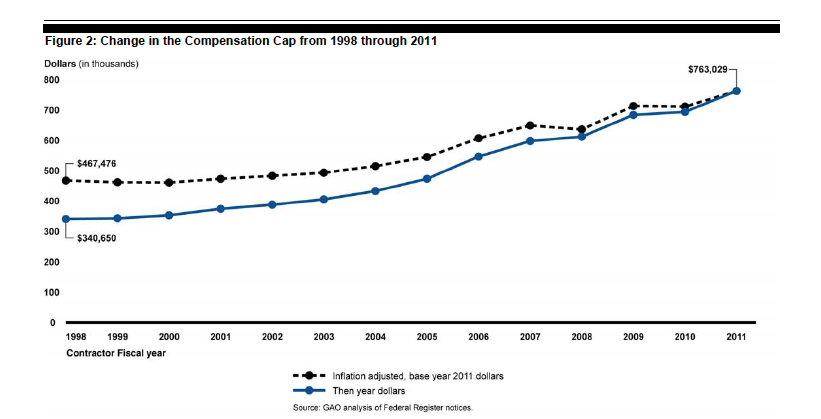Are defense-contractor executives paid too much?
It’s not like they work for Apple or Ford, where shareholders foot the bill, and – if they fail to produce the goods — they’ll feel that same foot kicking them overboard. They’re not sports stars, paid for by the team’s owner (even if the taxpayers foot the bill for the arena).
No. Defense contractors work for the American taxpayer.
That’s what makes Wednesday’s Government Accountability Office report into how much they’re paid worth noting.
Some data points worth pondering:
$763,029: the current cap on defense-contractor compensation. Contractors can pay their top executives more, but that additional share cannot be billed to the government as a part of the company’s contracts. In 2012, 141 executives working for 27 of 30 defense contractors of varying size were paid more.
The cap has grown by 63%, not counting inflation, since it began in 1998. The White House Office of Management and Budget “noted that the growth in the cap has outpaced the rate of inflation, the rate of growth of private sector salaries generally, and the rate of growth of federal salaries.”
$400,000: the President’s salary. There have been calls to limit reimbursable defense-executive compensation to this level. In 2012, 616 defense-contractor executives were paid $180 million more than this, an average of nearly $300,000 each.
$230,700: the Vice President’s salary. There have also been suggestions to limit reimbursable defense-executive compensation to this level. In 2012, 3,444 defense-contractor executives were paid $440 million more than this, an average of nearly $130,000 each.
Bottom line:
Government representatives generally supported reducing the cap as a means to reduce the costs of Department of Defense (DOD) contracts, whereas industry representatives and most contractors identified negative effects that could result from reducing the cap.
Defense executives warn that crimping their ability to pay their top talent what they’re worth will lead to F-35 engineers abandoning the program in favor of consumer products where no such comp-cap exists. But it’s a two-way street. Pentagon officials cited by the GAO say that the defense “industry would still be able to access necessary talent and noted that many positions within defense companies involve skills and capabilities readily available in the commercial marketplace.”
Besides that, the highly-compensated executives aren’t scientists and engineers. “DOD officials noted that few, if any, individuals whose compensation exceeds the current cap level are serving as a scientist or an engineer,” the GAO said. “All employees with compensation costs that exceeded the existing cap were identified as executives. Many of those above the existing cap were identified by their job title as corporate officers or executive vice presidents.”
But the most interesting data point – make that data pointless – was buried in the report:
We believe that the evidence obtained provides a reasonable basis for our findings and conclusions based on our audit objectives, with one limitation. We received complete responses to our data request from 27 of the 30 contractors in our sample—7 large-tier, 10 mid-tier, and 10 small-tier. The three largest contractors from which we requested data—The Boeing Company, Lockheed Martin Corporation, and Northrop Grumman Corporation—provided responses to our questions regarding company size, revenue, compensation practices and the potential impact of reducing the cap to the salaries of the U.S. President or Vice President. However, these contractors did not provide data on the number of employees with compensation costs greater than the salaries of the U.S. President or Vice President or on the estimated amount of total compensation that would no longer be allowable at these cap levels. These three contractors collectively accounted for about 18 percent of all DOD obligations in fiscal year 2012.
Boeing, Lockmart and Northrop Grumman also happen to be the Pentagon’s three biggest contractors.
Wonder what they’re afraid of?



